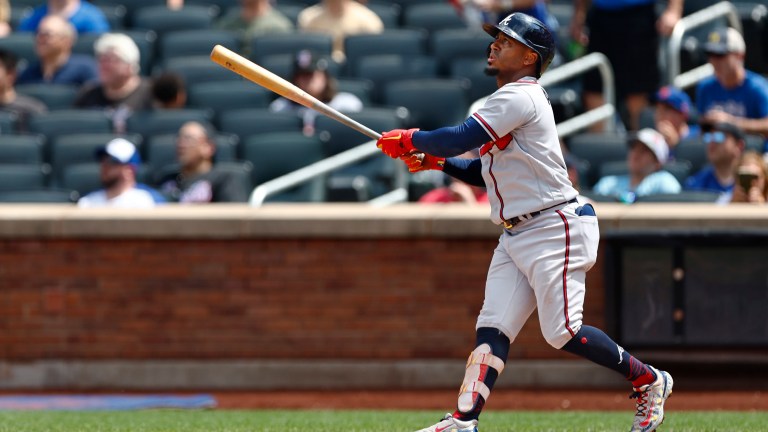Five Players Who Should Really Just Give Up on Switch-Hitting
Swinging the bat from both sides is a lost art in MLB. Today, we do a deep dive into a handful of switch-hitters who should drop that label.

Throughout the history of Major League Baseball, batters who can swing it from both sides of the plate have always been a work of art. Some of the best players of all-time were switch-hitters, including Hall of Famers Mickey Mantle, Eddie Murray, Ozzie Smith and Chipper Jones.
In today’s game, finding switch-hitters is more rare than ever before. In fact, there were only 62 players last year to register an at-bat from both sides of the plate. Most of them made under 10 appearances and don’t qualify on any major stat leaderboards.
Going even further, three teams (Tigers, Athletics, Astros) did not have a single switch-hitter on their teams all year long. The Blue Jays, Royals, Dodgers, Padres and Phillies each had a grand total of one.
An article from FOX Sports published in May of 2022 pointed out that around 12.5% of players were switch-hitters at the time. Last year, that was down to around 9.4%.
Seeing some of the game’s best – like Adley Rutschman, Anthony Santander, Ketel Marte, Carlos Santana and Jorge Polanco – on a nightly basis is a treat. Each of them managed to maintain an OPS+ at or over 100 last year from both sides of the plate.
Not Every Switch-Hitter Should be a Switch-Hitter
On the flipside, there are quite a few players who continue to function as switch-hitters despite the fact that their numbers suggest they shouldn’t be.
Sure, being able to hit a home run from both the right and left side of the plate is a nice tool to have, but if you strikeout 50% of the time and can barely hit your body weight from one side, maybe it’s time to give it up.
In the not-so-distant past, there have been a few examples of players that dropped the “switch-hitter” label. This includes Cedric Mullins, who immediately became an All-Star, Tucker Barnhardt and Shane Victorino.
Here, we take a closer look at a handful of switch-hitters who would be better off giving it up and hitting from their dominant side. A deep dive into the numbers suggests that there are more examples of this than you’d think.
Ozzie Albies
| Statistic | Vs. RHP | Vs. LHP |
| Batting Average | .250 (2,531 PA) | .338 (838 PA) |
| OBP | .311 | .364 |
| SLG | .447 | .570 |
| OPS | .758 | .934 |
| OPS+ | 89 | 134 |
For years now, Albies has come under fire for his inability to competently switch hit. The numbers speak for themselves, really. He typically faces a lot more right-handed pitchers than he does lefties, but the fact that the numbers are that skewed says a lot.
In 2023, the 27-year-old hit 28 of his 33 home runs from the left side, but he still hit just .250.
The numbers will suggest that he was better last year against righties than he historically has been, but the long history of dominance from the right side should lead to a permanent removal of the “switch-hitter” title.
Dylan Carlson
| Statistic | Vs. RHP | Vs. LHP |
| Batting Average | .221 (1,103 PA) | .306 (378 PA) |
| OBP | .304 | .377 |
| SLG | .368 | .472 |
| OPS | .672 | .848 |
| OPS+ | 88 | 137 |
To be clear, Carlson hasn’t been much of a consistent offensive threat since his breakout rookie campaign in 2021. This past year, he had a 111 OPS+ against left-handers and a 64 against right-handers. It’s pretty easy to see why his total OPS+ on the season was just 79.
Carlson so obviously sees the ball better on one side of the plate, making a change feel like an obvious move here. In 2023, he walked as many times as he struck out (12) while going down on strikes in just over 14% of his plate appearances.
As a left-handed batter, that numbers jump up to about 21.7%.
Elly De La Cruz

| Statistic | Vs. RHP | Vs. LHP |
| Batting Average | .256 (305 PA) | .184 (122 PA) |
| OBP | .328 | .231 |
| SLG | .471 | .263 |
| OPS | .799 | .495 |
| OPS+ | 124 | 41 |
De La Cruz burst onto the scene last year and quickly became one of the game’s most exciting rookies. His incredible speed on the bases and light-tower power was a blast to watch on an exciting, young Reds team.
After a red-hot month of June, his production gradually decreased as the year went on, but his L/R splits could’ve played a major role in that.
All of the numbers in the above chart are De La Cruz’s career ones, as he only just made his debut last year. He was virtually unplayable whenever a southpaw was on the mound as he struck out in just over 40% of his plate appearances against lefties.
The 22-year-old still has so many years of his big league career ahead of him, but if things continue like this as a switch-hitter, he should ditch that early on and reap the benefits.
Robbie Grossman
| Statistic | Vs. RHP | Vs. LHP |
| Batting Average | .229 (3,097 PA) | .282 (1,219 PA) |
| OBP | .332 | .381 |
| SLG | .360 | .426 |
| OPS | .692 | .808 |
| OPS+ | 91 | 123 |
It’s been a bit since Grossman was at his offensive peak, but he turned in a respectable season with the World Champs Rangers in 2023. The 11-year veteran managed to post an OPS+ of 100, the highest he’d had in years, while hitting 10 home runs in 115 games.
Grossman has the ability to lengthen his stay in the big leagues by making one significant change: dropping the switch-hitting label. Historically, he’s been a much better hitter from the right side of the plate, but 2023 took that to a whole new level.
All told, the 34-year-old hit just .206 as a lefty with a .633 OPS and 75 OPS+. As a righty, things looked much more promising. In 137 plate appearances, he hit .309, had an OPS over .950 and an OPS+ over 150. If he’s willing to make a change, he could ride out the rest of his career in style as a platoon bat who excels against left-handed pitching.
Ian Happ
| Statistic | Vs. RHP | Vs. LHP |
| Batting Average | .251 (2,354 PA) | .244 (838 PA) |
| OBP | .352 | .318 |
| SLG | .474 | .393 |
| OPS | .826 | .711 |
| OPS+ | 107 | 79 |
Happ, 29, remains one of the more consistent power threats in the National League, but he is not without his warts. Last year, he hit 21 home runs with a 112 OPS+ but 16 of those came from the left side of the plate. In fact, the vast majority of his numbers were carried by a strong showing as a left-handed hitter.
As a righty, he had an OPS+ of 88 with a .694 OPS that just couldn’t get it done. He has historically lost his power whenever he hits from the right side (20 home runs in 838 plate appearances) and has struck out in nearly 30% of those plate appearances. Time to give it a rest.
